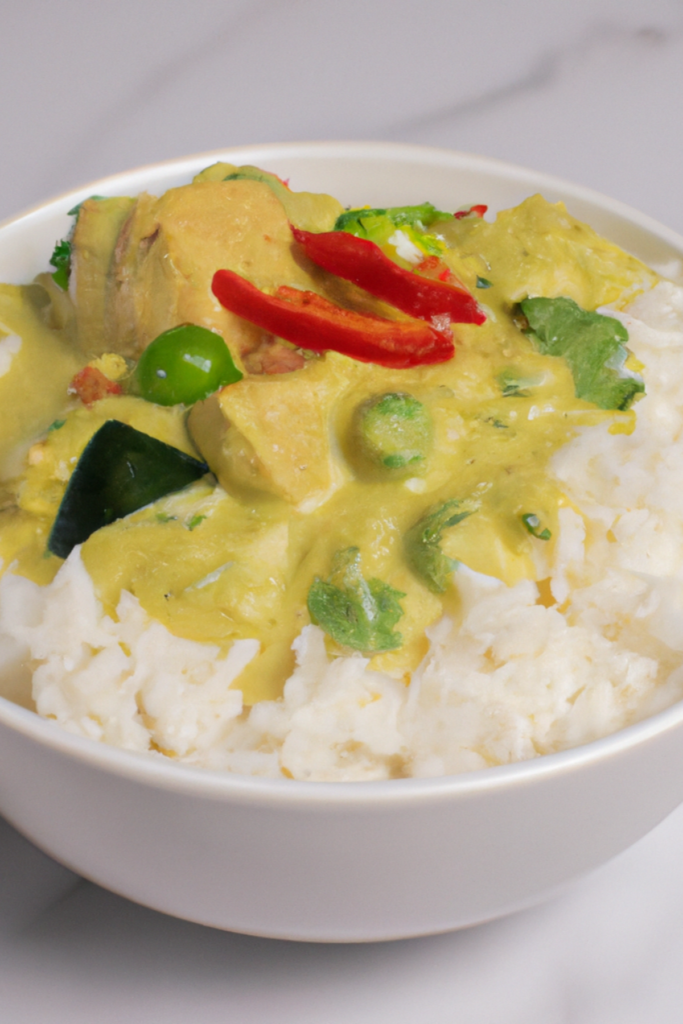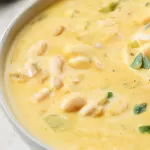This Easy Curry Sauce is beginner-friendly, quick to make, and convenient for a busy weeknight dinner. It’s designed to give you confidence in the kitchen, even if you’re short on time, but love to eat delicious, homecooked meals.

I love this quick curry because it’s so easy to make. While this recipe is a basic, hard-and-fast curried sauce, it’s loaded with intensely spicy flavors in a creamy coconut milk base, making for the most amazing comfort food.
More Sauces To Try
Ranch Dressing (No Buttermilk)
Garlic White Sauce
Boiling Crab Sauce
Peanut Sauce (for Dipping)
Peri Peri Hot Sauce
Easy White Sauce
Beef Gravy Sauce (No Drippings)
Homemade Marinara Sauce
Serve it over jasmine or basmati rice or lap it up with garlic naan bread for an authentic curry experience.
I love to serve this coconut curry sauce with chicken breast or beef strips, flash-fried in a glug of olive oil or butter, until cooked.
Then I set it aside while making the curry sauce, and return it to the pan to simmer in the sauce until heated through, and serve!
Table of Contents
Ingredients for Easy Curry Sauces
Olive Oil: Olive oil adds a smooth richness to the dish. You can use extra virgin olive oil for a more robust flavor.
Onion: Onions provide a solid foundation of flavor for the curry. You can use yellow, white, or red onions. Finely chopped onions will blend into the sauce better.
Fresh garlic: Fresh garlic adds aromatic intensity to the curry. Mince it finely for even distribution of flavor.
Fresh ginger: Fresh ginger brings a warm and slightly spicy note. Grating it ensures it melds seamlessly into the sauce.
Curry powder: Curry powder is a blend of various spices, offering a well-rounded curry flavor. You can find different types of curry powder, such as mild or spicy. Adjust the amount to your spice preference.
Sugar: Sugar balances the flavors and can help to mellow out the spiciness of the curry. You can adjust the amount to your taste.
Ground cinnamon: Ground cinnamon provides a subtle warmth and depth. Use it sparingly, as it can easily become overpowering.
Salt: Salt enhances the overall flavors of the dish. Start with a little and adjust to taste as the curry simmers.
Tomato paste: Tomato paste contributes a tangy richness and deep color to the curry. It acts as a flavor enhancer.
Chicken stock: Chicken stock adds a savory depth to the curry. Use low-sodium stock if you’re concerned about salt content.
Coconut milk: Coconut milk gives the curry its creamy and luscious texture. Choose full-fat canned coconut milk for the best results. Shake the can well before opening.
How to make Coconut Curry Sauce
This creamy curry sauce is incredibly easy to make and will take only a few minutes to prepare. Here’s how:
Sauté Aromatics:
In a large skillet or saucepan, heat the olive oil over medium heat. Add the chopped onion and sauté for 3-4 minutes until it turns translucent.
Add Flavor Base:
Stir in the minced garlic and grated ginger, cooking for an additional 1-2 minutes until fragrant.
Introduce Spices:
Sprinkle the curry powder, sugar, ground cinnamon, and salt into the skillet. Mix well to coat the onion mixture with the spices.
Deepen Flavors:
Incorporate the tomato paste, stirring it in to combine with the spiced onion mixture. Allow it to cook for about 2 minutes, allowing the flavors to meld.
Pour in Liquids:
Pour in the chicken stock and coconut milk, stirring to create a smooth and aromatic base.
Add Chicken, Beef, Shrimp, or Veggies:
Gently place the bite-sized chicken pieces into the curry sauce, ensuring they are fully submerged.
Simmer and Cook:
Bring the mixture to a gentle simmer. Cover the skillet with a lid and let the curry cook for about 15-20 minutes, or until the chicken is cooked through and tender.
Adjust Consistency and Seasoning:
If you prefer a thicker sauce, you can let the curry simmer uncovered for a few more minutes. If it’s too thick, you can add a bit more chicken stock or water to achieve the desired consistency.
Taste and adjust the seasoning with more salt if needed.
Serve and Enjoy:
Once the chicken is cooked and the flavors are well-blended, your creamy coconut chicken curry is ready to be enjoyed.
Serve the curry over a bed of cooked white rice, and garnish with fresh cilantro or chopped green onions if desired.
Ingredient notes for this recipe
Feel free to adjust the quantities of spices, sugar, and salt to suit your taste preferences.
When working with fresh ginger, you can peel it using a teaspoon and then grate it using a fine grater or microplane.
If you’re looking for a vegetarian version, you can replace chicken stock with vegetable stock and use vegetables or tofu instead of chicken.
Remember that the quality of your curry powder will greatly impact the flavor of the dish. You can make your own curry powder blend or choose a high-quality store-bought option.
Experiment with additional vegetables like bell peppers, peas, or carrots for added color, texture, and nutrition.
Garnish options include fresh cilantro, chopped green onions, or a sprinkle of toasted coconut flakes.
Substitutions in this recipe
Olive Oil: Substitute with any neutral oil like vegetable oil, canola oil, or sunflower oil.
Onion: You can use shallots or leeks as a substitute for onions.
Fresh garlic: If you don’t have fresh garlic, you can use garlic powder. Use 1/4 to 1/2 teaspoon of garlic powder per clove of fresh garlic.
Fresh ginger: Ginger paste or ground ginger can be used as a replacement. Use about 1/4 to 1/2 teaspoon of ground ginger for every tablespoon of fresh ginger.
Curry powder: If you don’t have curry powder, you can create your own blend using ground cumin, coriander, turmeric, and a pinch of cayenne pepper for heat. Start with equal parts cumin and coriander and a smaller amount of turmeric and cayenne.
Sugar: Substitute with honey, maple syrup, agave nectar, or brown sugar. Adjust the quantity to your taste.
Ground cinnamon: You can use cinnamon sticks, a pinch of ground nutmeg, or allspice for a warm flavor.
Salt: Use any other salt you have on hand, such as sea salt or kosher salt.
Tomato paste: You can replace tomato paste with tomato sauce or crushed tomatoes. Just be aware that the consistency might be slightly different, so adjust the quantity accordingly.
Chicken stock: Substitute with vegetable stock or broth for a vegetarian version.
Coconut milk: You can use almond milk, soy milk, for a vegan sauce, or diluted yogurt for a lower-fat version.
Boneless chicken: Replace chicken with tofu, shrimp, or your choice of protein. Adjust cooking times accordingly.
These substitutions might alter the final flavor and texture of the dish, so it’s a good idea to adjust quantities and taste as you go along.
Variations of this Curry Sauce
Vegetable Curry: Substitute chicken with a mix of your favorite vegetables like bell peppers, carrots, potatoes, peas, and cauliflower. Use vegetable stock instead of chicken stock.
Thai Red Curry: Replace curry powder with red curry paste. Add a tablespoon of fish sauce and a teaspoon of brown sugar for authenticity. Use a mix of vegetables and proteins like shrimp, tofu, or sliced beef.
Lentil and Chickpea Curry: Replace chicken with a mix of cooked lentils and canned chickpeas. Add extra spices like ground cumin, coriander, and turmeric for depth of flavor. Serve this protein-rich lentil and chickpea curry with rice or flatbread for a hearty and satisfying meal.
You really can’t go wrong with this foolproof curry recipe, so don’t be afraid to add whatever ingredients you want, to create your own signature curry sauce.
How to store Curry Sauce
Storing curry sauce properly is important to maintain its freshness and flavor. Here’s how to store your easy curry sauce:
Refrigeration: Allow the curry sauce to cool down to room temperature before refrigerating it. Transfer the curry sauce to an airtight glass or plastic container.
Freezing: Allow the curry sauce to cool completely before freezing. Portion the sauce into smaller airtight containers or freezer-safe bags.
Remove excess air from freezer bags before sealing to prevent freezer burn and allow for expansion during freezing.
Store the curry sauce in the freezer for up to 3 months. After that, the quality might start to decline.
Thawing and Reheating: Transfer the frozen curry sauce from the freezer to the refrigerator and let it thaw slowly.
This might take several hours to overnight. Once thawed, gently reheat the curry sauce on the stovetop over low to medium heat. Stir occasionally to ensure even heating.
If you’re reheating a large portion, you can use a microwave, using short intervals and stirring in between to prevent hot spots.
Recipe Tips and Tricks
Sauté Aromatics Thoroughly: Take your time sautéing the onions, garlic, and ginger, to develop deep flavors for your sauce.
Spice Balance: Adjust the curry powder and other spices to your taste preference. Add a pinch of cayenne pepper for more heat.
Controlled Cinnamon: Use ground cinnamon sparingly, as it can overpower the dish. Start with a small amount and add more if needed.
Browning Tomato Paste: Let the tomato paste cook for a couple of minutes after adding it to the spices. This helps to intensify its flavor.
Gradual Stock Addition: When adding chicken stock, pour it in gradually while stirring. This prevents lumps and ensures a smooth sauce.
Creamy Coconut Milk: Shake the can of coconut milk well before opening to mix the solids and liquids. This ensures a consistent creamy texture.
Chicken Cooking Time: If using chicken, avoid overcooking it, as it can become tough. Simmer until just cooked through to retain tenderness.
Taste and Adjust: Regularly taste and adjust the seasonings as you cook. It’s easier to balance flavors along the way.
Fresh Herbs Garnish: Chopped fresh cilantro or mint can be a refreshing garnish that adds color and a burst of fresh flavor.
Extra Creaminess: If you desire a richer sauce, stir in a tablespoon of butter or heavy cream at the end.
Consistency: Let the curry simmer uncovered for a little longer for a thicker sauce. If it’s too thick, add a bit of chicken stock or water to achieve the consistency you like.
Easy Curry Sauce FAQs
Can I use store-bought curry paste instead of curry powder?
How can I make my curry sauce less spicy?
Is it necessary to use tomato paste in curry sauce?
This is one of the best and most versatile curry sauces I’ve made, and I hope you’ll try it (and love it!) too. Let me know how it goes!
Easy Curry Sauce
Ingredients
- 2 tablespoons olive oil
- 1 onion finely chopped
- 3 cloves fresh garlic minced
- 1 tablespoon fresh ginger grated
- 2 tablespoons curry powder
- 1 teaspoon sugar
- 1/2 teaspoon ground cinnamon
- 1/2 teaspoon salt or to taste
- 2 tablespoons tomato paste
- 1 cup chicken stock
- 1 can coconut milk
Instructions
- In a large skillet or saucepan, heat the olive oil over medium heat.
- Add the chopped onion and sauté for 3-4 minutes until it turns translucent.
- Stir in the minced garlic and grated ginger, cooking for an additional 1-2 minutes until fragrant.
- Sprinkle the curry powder, sugar, ground cinnamon, and salt into the skillet. Mix well to coat the onion mixture with the spices.
- Incorporate the tomato paste, stirring it in to combine with the spiced onion mixture. Allow it to cook for about 2 minutes, allowing the flavors to meld.
- Pour in the chicken stock and coconut milk, stirring to create a smooth and aromatic base.
- Simmer the sauce until desired consistency.
- Taste and adjust the seasoning with more salt if needed, and serve.
Similar Recipes
- Easy Shrimp And Scallop Paella
- White Chicken Chili Without Cream Cheese
- Air Fryer Tandoori Chicken Legs
- 4 Cheese Pasta {Cheesecake Factory Copycat}
- Chicken Marsala Recipe
Get our FREE Printable Meal Planner and other helpful goodies straight to your inbox!








